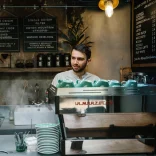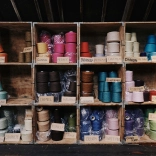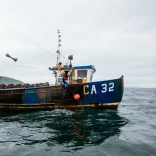How did you get the idea of making gin in deepest rural Wales?
My brother Pete moved to the Dyfi valley 35 years ago to study environmental biology. He’s been foraging here ever since, and hill-farming and bee-keeping for 25 years. So Pete is intimately connected with this landscape. I’ve spent my life in the wine and spirits industry, and we thought it would be fascinating to combine our respective skills. Gin was the obvious route, because both of us are interested in producing something that tastes of where it comes from.



Why is the Dyfi area so special?
We’ve got this amazing botanical diversity here, and very low pollution levels. It’s now recognised by UNESCO as a world biosphere reserve, because of the diversity of the flora and fauna, and the human interaction with that environment. It’s a forager’s paradise.

What botanicals do you use?
There’s a combination of classic gin botanicals, and we marry these with our foraged components. Dyfi Original is the most ginny gin we make. Out of the 10 botanicals we use three foraged ones: bog myrtle, conifer tips and gorse flowers. Bog myrtle and juniper have a combined history in drink production that goes back a thousand years, so they have very symbiotic flavours.


What about Pollination Gin?
Pollination is botanically more complicated. We use 29 botanicals and 20 of those are foraged.
Pollination has more the influence of wild flowers and green leaf components. We had a visitor recently say that it’s the gin equivalent of walking through a wild flower meadow, which is a very nice way of putting it.
Danny Cameron, Founder of Dyfi GinThe dominant botanicals are wild crab apples, blackberries and bilberries. It gives it a roundness and a richness, and the barrel gives us a depth of flavour."
And Hibernation Gin?
Hibernation is our barrel-aged gin. It’s the first gin in the world to be aged in a 100-year-old white port barrel, and we’ve developed the botanicals to marry with that barrel character. The dominant botanicals are wild crab apples, blackberries and bilberries. It gives it a roundness and a richness, and the barrel gives us a depth of flavour.
Do you ever walk along and think, “Ooh, there’s some meadowsweet – I wonder what that would taste like?”
Actually, meadowsweet is a very important one in Pollination. It’s known locally as blodau’r mêl, which means ‘honey flower’, and it’s such a wonderful thing. Meadowsweet was being used to flavour ale 3,000 years ago, and it’s a widely foraged botanical in Dyfi. A lot of people who’ve lived here for generations gather it and dry it and use it to make a tea infusion.



Any flowers or plants that really don’t work?
We were walking along a little country lane and there was some honeysuckle in flower. It was gorgeously aromatic in its natural environment. We thought it could be a brilliant cornerstone of our gin. But when we actually micro-distilled it and tried blending it with other floral components, it was incredibly disruptive. We edited it out of the final jigsaw. It was the piece that wouldn’t fit.
Danny Cameron, Founder of Dyfi GinMeadowsweet was being used to flavour ale 3,000 years ago, and it’s a widely foraged botanical in Dyfi."
Where can I get hold of Dyfi gin?
We have the little shop at the visitor facility, and we also sell online via the Dyfi Distillery website. We’ve got about 40 retail partners dotted around the UK. At one end there’s Selfridges and Fortnum & Mason, and at the other end very good quality independent wine and spirits merchants.
Why bother with a visitor centre? Isn’t it a distraction?
The visitor centre is such an important part of what we do. Yes, we could have our heads down and produce gin all the time. But the opportunity to come face-to-face with our customers - I couldn’t put a price on that. We don’t do formal tours, but we make people very welcome when they come, they can have a chat and a taste, so hopefully everybody wins. A few days ago a gentleman came in from Brisbane in Australia. He’d spent two years planning his entire holiday around being able to come to the Dyfi Distillery.
What are your favourite places locally?
Anything that celebrates local produce and provenance is always going to make me very happy. If you’re in the area, go and climb up Cader Idris, visit the Dyfi Osprey Project, and go and see the dolphins in Cardigan Bay. It’s just a place of gorgeousness, and that extends to the people who live here as well as the environment. It’s as close as you get to paradise.






